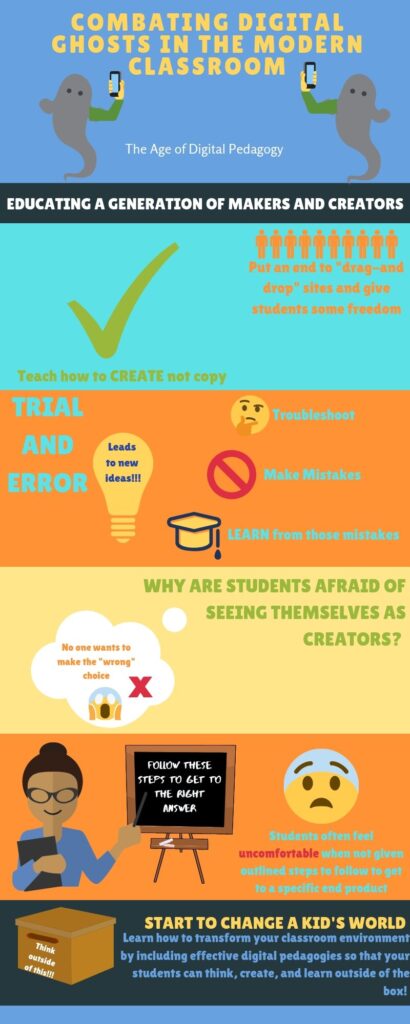For this assignment, I chose to take a look at the article “Digital Ghosts in the Modern Classroom” by Ashley Hinck. I was intrigued by the ideas in her article and could also relate to many of those ideas. I think that she is absolutely right about the culture in schools surrounding digital technology being that it is there to make our lives easier by staying limited to sites that have templates that create one end product. I can understand why teachers may enjoy those kind of sites; it could make it easier to grade projects if they all look the same, there would be clear elements to compare and contrast. This type of template software removes the creativity and exploration out of the classroom.
We need to start educating “makers” and “creators”, instead of teaching in a way that emphasizes uniformity within the students. Trial and error is a huge part of the learning process, and I believe that should apply while learning with digital technologies as well. When students learn to be comfortable troubleshooting ideas and making mistakes, it will lead to learning and most importantly, creativity and individuality. Our school culture is one of following instructions and producing an end product that meets all of the teacher’s criteria, so removing those guidelines and allowing students to create in their own way can be a tricky process.

Hinck made a very interesting point in her article when she said “Are we really teaching them [students] to make, or are we just teaching them to drag and drop or to effectively follow a set of rigid instructions in order to achieve a static goal?” At stake is whether students create something someone else envisioned or whether they get to learn to create, compose, and make.” (Hinck 2018). I can relate to this statement because from my own experience going through the school system that I did, most of our projects that were produced using some type of digital technology, had a strict set of guidelines and set software and websites that we were allowed to use. Our main goal was then to meet the criteria given and surely not make any mistakes in the fear that our final product would be so different than what everyone else had done.
In my future classroom, I intend on using more open-ended sites to enable and privilege openness and experimentation for my students, as Hinck had mentioned in her article. For example, using Canva for this project was a challenge for me because I was so used to having a set template to fill in, but having that openness for me to create what I felt was important and represented my own ideas, was a great learning experience. I also think that it would be a great idea to go off of what Hinck described to “emphasize this movement toward trial-and-error and tinkering” and show students some of our own struggles and failures using digital technologies to make them feel more comfortable using technology and getting them to see their projects as a work-in-progress as opposed to a failure.
